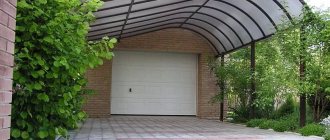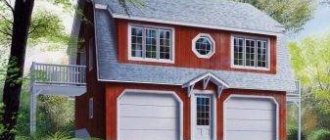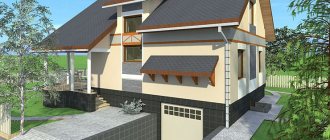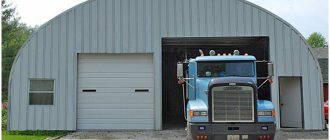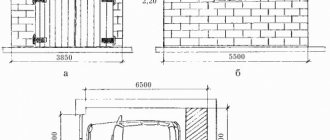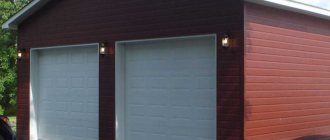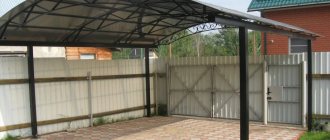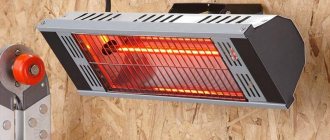You can arrange buildings on your own site as you wish. In this case, fire safety standards and the distance from the fence to the garage and neighboring buildings that have already been erected or are being built must be observed.
There are several legislative documents for the construction of a garage. They do not contradict each other, but operate on different planes. The main ones are fire safety rules, which must be followed strictly. Some standards are advisory in nature.
According to the current legislation of the Russian Federation, a garage is classified as an outbuilding.
Based on Article 51 of the Civil Code, Articles 1 and 17, obtaining permission to build a garage on a private plot is not required.
But this does not mean that it can be built anywhere.
The neighboring plot is empty
SNiP regulates the distance when constructing a garage from the fence, on the side and in front, as well as from the nearest neighboring building and the red line. In this case, the right of the first developer matters.
A garage on an undeveloped plot can be located no closer than 1 meter from neighbors
If construction of a house and outbuildings on neighboring plots has not yet begun, then the garage can be placed at a distance of 1 m from the neighboring fence. The measurement takes place from the extreme point of the base to the demarcation line, in this case, the fence.
According to SNiP, wastewater from the roof should not fall onto someone else’s property. The passage between the building and the fence must remain free.
A free passage between the garage and the fence ensures good drainage of water from the roof
Before building a garage, talk to your neighbor. If he already has an approved development plan for the site, primarily a house, then this is equivalent to the start of construction and is legally valid at the level of existing buildings.
Smart planning
The garage can be an extension or a separate building. Each case has its own design features.
We advise you to read: “The distance from the house and other buildings to the neighbors’ fence.”
Attached
A garage can be attached not only to the house, but also to a bathhouse, summer kitchen, etc. It should be below floor level and can be used as a storage room. Heating is not a requirement of SNiP; its installation is at the discretion of the owner.
If the garage is not a separate building, then:
- it has a separate foundation and cover;
- it does not take up much space in the yard;
- Entry is possible directly from the street (especially convenient when using automatic gates).
The attached garage should have good sound insulation and a high-quality roof (preferably from the same material as in the house). All communications are possible, but the decision remains with the owner.
If the house has two floors, it is better not to place the garage under long-term rooms, such as a bedroom.
Standing separately
If this is a separate building, then it can be built from leftover building materials and other budgetary methods. Sound insulation in this case is optional.
At the detached garage:
- the foundation must be poured;
- communications are required, which requires additional costs.
To get into a separate garage you will have to go outside every time. You can make a canopy so you don't have to walk to your car in the rain, but this involves additional costs.
The neighboring plot is built up
If there are buildings on a neighboring site and work is being carried out to create a foundation, the 6-meter rule comes into force. The garage must be located more than 6 m from the nearest neighboring building.
These rules ensure safety in the event of man-made accidents and other types of damage and fires that occur.
In the event of a fire, the fire should not easily spread to other buildings
During simultaneous development and when a neighbor is building later, but wants to locate the house closer to your existing garage than 6 meters, an agreement is concluded between the neighbors. It is legally certified.
Litigation
Clarification of relations between neighbors in the courts is an extreme measure used in cases where it is impossible to find mutual understanding. But if it is not possible to dispose of your land to build a garage due to unfounded claims, then there are no other ways to prove your case.
Buildings in SNT and individual housing construction
To consider the case in court, the plaintiff prepares and submits a statement of claim accompanied by title documents of a housing nature. Their list duplicates the necessary papers for approval of the project by the administration architects.
Distance from red line
The second part of the garage location rule concerns the so-called red line. This is usually the front boundary of the property facing the road. The line along which all government communications, underground and overhead, pass:
- water pipes;
- sewerage;
- power line;
- connection;
- gas supply.
The red line with communications must be at a sufficient distance from the garage
In addition to the systems listed above, others may also pass through.
The garage should be located 5 m from the red line. By complying with this condition, you comply with the requirements of local authorities and road inspectors. The car in front of the garage must be parked on the site, not occupying the roadway or sidewalk.
The parking space between the garage and the road should not block the passage of other cars on the road
The distance from the garage to the fence can be reduced, and even made into one line, if the fence is moved a meter from the red line towards the site and coordinated with local government and fire safety authorities.
The fence must be moved along its entire length, and not just in front of the garage, creating a free area for passage in the event of an emergency or fire.
A garage with a parking space must be located on the site
Preparation of the drawing
A high-quality drawing is the key to successful work for a master. The following parameters must be displayed on the plan diagram:
- Dimensions of the building.
- Pit dimensions.
- Foundation pouring depth.
- Door structures and the principle of their operation.
If you wish, you can use ready-made drawings of various garages that are freely available.
Additional requirements
At what distance from the property line can a garage be located if there is an alley on the side? Regardless of the width and intensity of the dirt road or just a pedestrian area, the house for the car should be located no closer than 3 m from the side fence and the street.
This requirement of SanPiN is based on fire safety; in the event of an emergency, transport must pass freely between areas.
Acceptable layout of the garage on the site
The provision applies to the house, all outbuildings and structures related to small architectural forms:
- gazebo;
- pergola;
- awnings;
- greenhouse;
- summer houses.
Requirements for a garage built into a house are imposed on the general principles of a permanent building
The boundaries are determined at a distance of 6-10 meters from the fence, depending on the material of the walls. For wooden houses - 15 m. It is prohibited to arrange living rooms above the garage:
- bedrooms;
- children's;
- kitchen-dining rooms;
- living rooms.
Construction documents
According to Part 2 of Art. 51 of the Town Planning Code of the Russian Federation, permission is required for the construction of any capital structure. This means that you can build a garage without it if it:
- metal structure without a foundation, with the ability to move using a crane;
- a structure in the form of a canopy without main walls.
If a structure with a foundation is a taxable immovable property and the construction of which requires a permit.
If the garage will be used for commercial purposes, a permit is required, regardless of the type of structure.
To receive it, you need to submit to the municipal architecture department:
- statement from the owner of the site;
- passport;
- technical plan of the land;
- documentary evidence of ownership of the site;
- future garage project;
- cadastral plan of the site;
- communications connection plan;
- topographic map of the site.
The permit is issued free of charge, but you will have to pay for the services of obtaining cadastral and technical plans, as well as a topographic map. Their cost is determined by the region of residence.
Recommendations from a specialist on choosing a place to build a garage
When constructing an inspection pit, it is necessary to conduct geodetic exploration of the soil and soil waters. If the location is close, choose another place or waterproof the pit. This is explained in the following video:
When developing a project, experts recommend immediately planning to build a garage on the north side of the site. Then it will not block the sun for plants around the house and limit the light flow.
The location of the garage in the northern part of the site is recommended, but not mandatory
This point of the designers is advisory in nature and is more suitable for farmers who use the site for growing vegetables and fruits.
Do I need permission?
A shed instead of a garage is not regulated by SNiP norms and no permit is required for its construction.
A garage can be a light building: metal, concrete box or shed. This structure can be installed on any flat surface and does not require a foundation. Its position is not regulated by SNiP norms and permission is not required for its construction.
A structure on a foundation, even the lightest one, is a standard construction project. Permission is required for this. Often they receive it only if the plot is intended to be sold.
It is recommended to obtain permission when building on a site of the individual housing construction type. The requirements for development here are the most stringent.
Distance from the fence during garage construction: documentation and SNiP standards
The following standards apply to detached and attached garages built on private plots for personal cars:
- SNiP 2.07.01 – 89. “Urban planning. Planning and development of urban and rural settlements";
- Urban planning complex of the Russian Federation 12.29.2004, No. 190-FZ;
- “Fire safety rules for buildings and structures” dated 21.01. 1997;
- Fire safety standards No. 53.13330.2011.
The garage should be located 1 m from the neighboring fence, and 6 m from the windows, veranda and walls of the neighboring house
The measurement is taken from the edge of the protruding plinth or walls, which stands out more outward, to the line of the nearest element of the neighboring building. Balconies protruding above the level of the roof of the building for the car are not taken into account unless they have columns and capital supports of another type.
Maintaining the required distances between the garage, the fence and the nearest building on the neighboring site will protect you from administrative liability, disputes with neighbors and forced demolition of the building
Violation of the requirements of SNiP 2.07.01 - 89 and SNiP 21.01 - 97 will not entail criminal punishment, since in relation to outbuildings, which include garages, regulatory documents are advisory in nature.
Fire safety regulations must be observed; violation of them is punishable by fines and even demolition of structures.
You can ignore them on your site, but after construction the garage must be registered with the BTI, so troubles may arise.
How to behave correctly with neighbors without violating their rights
To avoid conflicts, you need to be guided by the requirements of SNiP and regional regulations governing the rules for the construction of outbuildings.
Read more about the rules of behavior with neighbors in the article: “Measure seven times...”, or how to maintain the distance between buildings on your site and not offend your neighbor.
It’s easiest for owners of plots located next to empty plots - they only need to meet one requirement: a distance of 1 m from the garage to the border with neighbors.
Those who are building next will have a more difficult time. The best option for preserving peace is dialogue with the owners of neighboring plots.
It is worth warning about your intentions and obtaining consent, secured by a notarized agreement.
However, given that the agreement is valid for 3 years, and if the owner of the neighboring plot changes, it becomes invalid, there is no guarantee that disputes over boundaries will not arise. Therefore, it is advisable to adhere to the legal requirements as much as possible in order to have an advantage in the event of a conflict.
Fire safety standards
Fire safety requirements include a number of points that will help avoid a fire:
- the supply of electricity from the house to the garage is carried out with an insulated cable in accordance with PTEEP standards, without breaks or bare spots;
- the wire is placed in a metal sleeve;
- fuses are installed at the input;
- light bulbs with protective shades;
- presence of a fire extinguisher in the garage and car;
- no heating;
- floor with anti-slip coating, resistant to oils;
- a box with sand for removing spilled fuel and lubricants and extinguishing fires on the floor;
- outside fire shield;
- do not leave the car with an open fuel tank;
- smoking area outside the garage.
It is better to observe fire safety in the private sector so that outbuildings and the house on the entire site do not burn down
You should not store cans next to your car in the garage. It is better for them to make a room behind the garage with a separate entrance.
Electric heating devices and switched-on power tools must not be left unattended.
Immediately during construction, create paths 70–80 cm wide around the base. They will protect the foundation from wastewater and ensure free passage.
Features of the neighborhood with wooden buildings
The proximity to a farmstead where a wooden residential building is built increases the mandatory distance to 15 m. At the same time, the right to agree with the owner on reducing this distance is retained. Consent is drawn up in writing and certified by a notary.
The same procedure for neighbors to resolve the issue applies to brick buildings, if it is necessary to build a room for a car at a distance of less than 6 m. A prerequisite for receiving a positive answer from a neighbor is to ensure sufficient fire safety measures.
Small building
To do this you need:
- install an external shield with recommended fire-fighting accessories;
- place a fire extinguisher in the room;
- ensure that the room is not heated;
- place the electrical power supply distribution panel outside the building;
- equip the electrical panel with an automatic load switch;
- trace the wires in a protective metal sleeve;
- equip lighting devices with factory shades.
Pouring the foundation
In practice, the most common type of foundation for garages is the strip type. Instructions for organizing a quality foundation:
- It is necessary to dig a trench in the ground of the proper depth and width (depending on the size of the garage).
- Carefully level the walls and bottom.
- Broken bricks, glass, and metal parts are placed at the bottom of the trench.
- Prepare a mortar for pouring from a mixture of sand, cement and water. Sometimes gravel is used as an additional component.
During the drying process of concrete, the pouring surface is periodically moistened with water to prevent the appearance of cracks.
Garage in a private house. Is there an alternative?
If the construction budget is limited, you can do without a garage altogether and replace it with a special canopy, under which the car can feel quite comfortable. Or you can even think through the design of the house so that it is located above the garage.
A free-standing carport has several advantages over a garage:
- it is mobile - it can be moved to a new location without much difficulty if necessary;
- scalable - if necessary, the canopy can be expanded;
- inexpensive - the most attractive feature.
However, we will not consider canopies, since this is still not a garage, and it is unsuitable for permanent, especially winter use.
